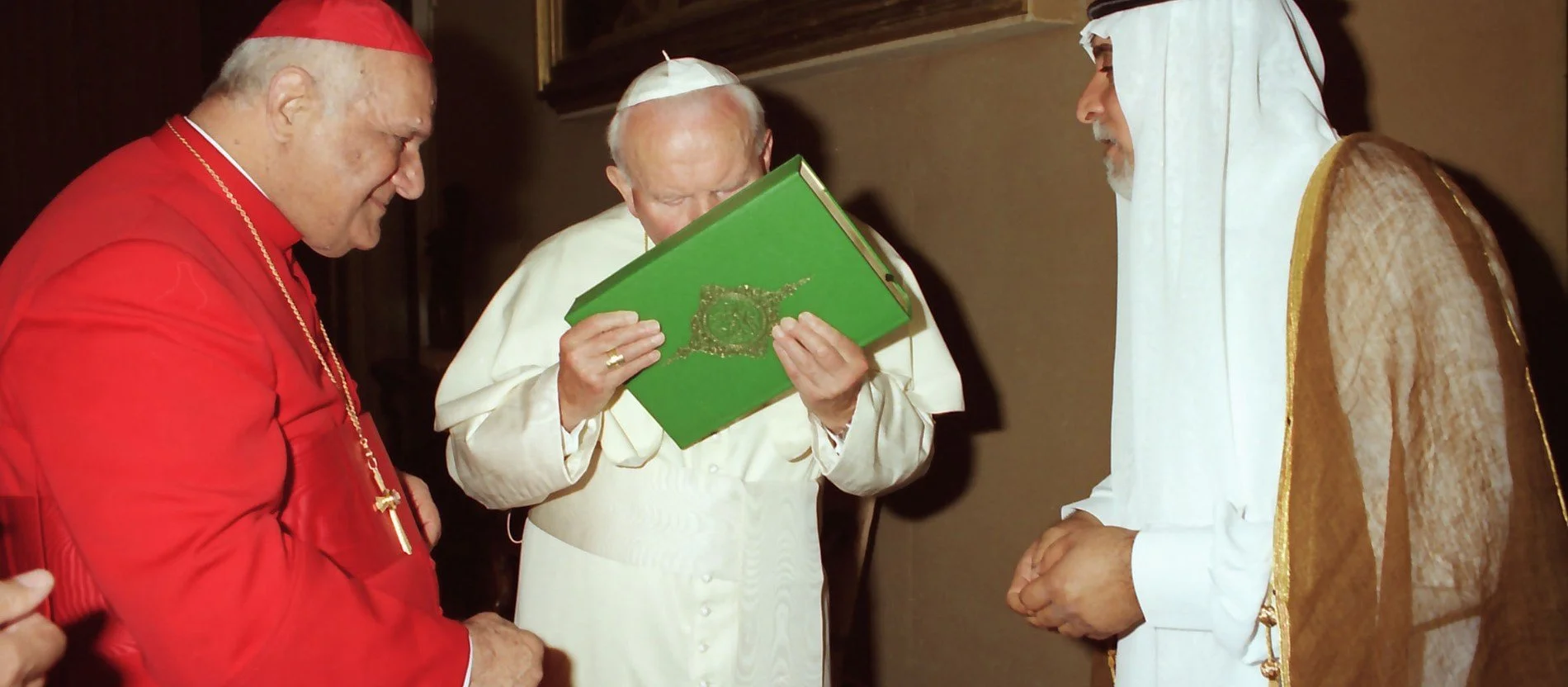8.162. Wasn’t Pope John Paul II just being respectful by kissing the Qur’an and receiving a Hindu blessing? Isn’t that a beautiful gesture of peace and interreligious humility?
This perception is common in the post-Vatican II world, where false ecumenism and interreligious dialogue have replaced the Church’s clear teaching on the First Commandment and the exclusivity of the Catholic Faith. But in truth, what John Paul II did was not humility—it was public apostasy.
In 1999, John Paul II kissed the Qur’an, a book that explicitly denies the Trinity, rejects the divinity of Jesus Christ, denounces the Crucifixion, and calls for the subjugation of Christians. Kissing it is not a neutral gesture—it is a symbol of reverence, and it gave the appearance that the head of the Catholic Church was honoring a blasphemous, anti-Christian text.
Earlier, in 1986, during a visit to India, he participated in a pagan Hindu ceremony, where he received the tilak, a ritual mark of consecration to the god Shiva, on his forehead. This is not a cultural formality—it is a religious rite of idolatrous worship.
The same year, he presided over the infamous Assisi interreligious prayer event, where leaders of false religions—including witch doctors and Buddhists—prayed in Catholic churches, some offering incense and chanting to idols on altars once reserved for the Sacrifice of the Mass.
While modern Vatican II theology praises such gestures as “dialogue” or “mutual respect,” true Catholic theology condemns them as blasphemy, scandal, and grave sin.
The First Commandment does not say “respect all gods.” It says:
“Thou shalt not have strange gods before Me.”
The Church has always taught, as Pope Pius XI warned in Mortalium Animos (1928), that it is forbidden to participate in joint worship or give honor to false religions. These actions suggest that all religions are equal, which is a condemned heresy.
No true pope, protected by the Holy Ghost from public apostasy, could perform such scandalous acts. Therefore, John Paul II could not have been a true pope. He revealed himself to be a manifest heretic and public apostate, who led millions into error through actions contrary to divine and Catholic Faith.
| Category | Traditional Catholic Teaching | John Paul II’s Actions | Remarks |
|---|---|---|---|
| Worship of False Religions | Gravely sinful; condemned by First Commandment | Participated in Hindu ritual; received mark of Shiva (1986) | Symbolic act of idolatry; publicly honored a false god |
| Holy Scriptures | Only Sacred Scripture and Catholic teaching are reverenced | Kissed the Qur’an (1999) | Honored a book that denies Christ and the Trinity |
| Respect for the Faithful | Pope must protect the faithful from scandal and error | Created massive confusion and scandal worldwide | Faithful were misled to believe false religions are salvific |
| Ecumenism and Interfaith | Joint worship with false religions is forbidden (*Mortalium Animos*) | Led Assisi interreligious prayer event (1986) | Placed idols on Catholic altars; mocked the uniqueness of Christ |
| Papal Infallibility and Office | A true pope cannot publicly apostatize or promote false worship | Repeated, deliberate participation in anti-Catholic rituals | Public actions disqualify him as a valid pope under divine law |
| Fruits | Sanctity, conversions, defense of the Faith | Indifferentism, syncretism, collapse of missionary spirit | “By their fruits you shall know them” (Matt. 7:16) |
Summary:
What seemed to be gestures of humility or peace were, in reality, grave offenses against the Catholic Faith. John Paul II’s kissing of the Qur’an and participation in pagan ceremonies were not acts of love, but of public betrayal of Christ. They promoted the falsehood that all religions are valid paths to God—when in truth, there is no salvation outside the Catholic Church.
As St. Paul wrote:
“What agreement hath the temple of God with idols?”
“But though we, or an angel from heaven, preach a gospel to you besides that which we have preached, let him be anathema.”
Further reading:
Mortalium Animos (On Religious Unity) by Pope Pius XI (1928)


